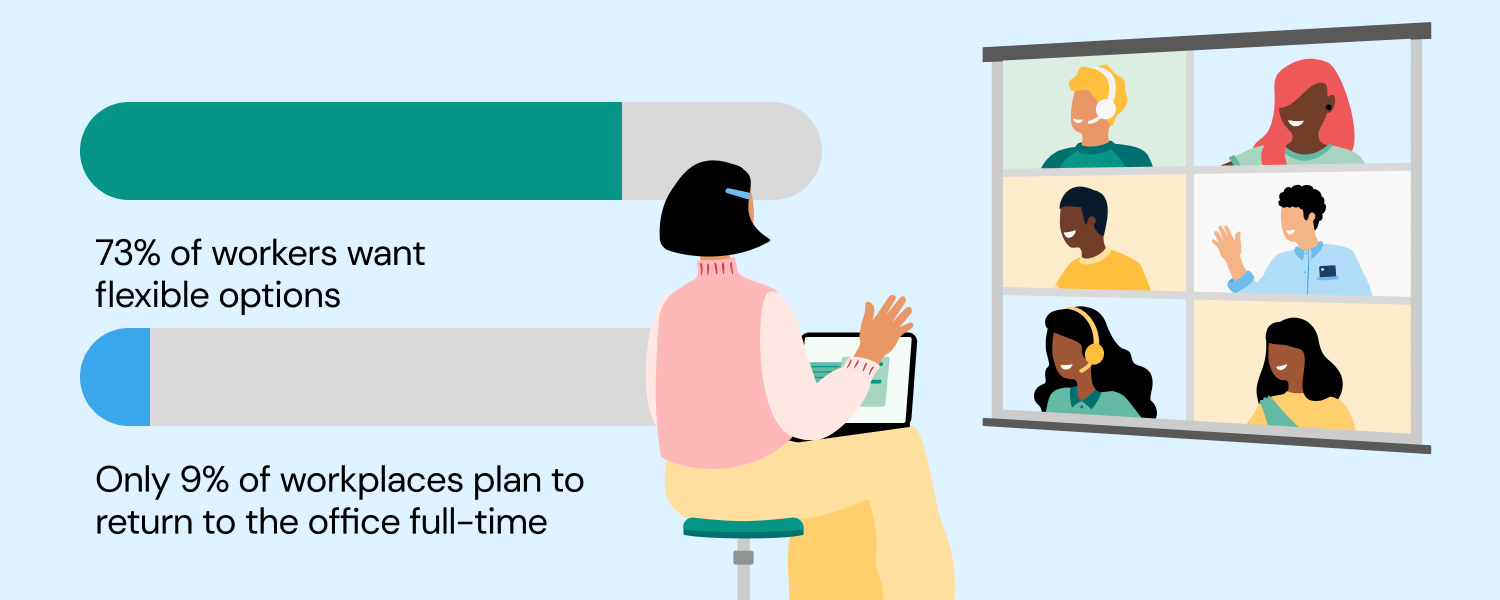In this article:
- Workers now demand flexibility
- Many leaders need a wake-up call
- Signs show hybrid work models improve wellbeing
- The different types of hybrid work models
- The at-will model
- The split-week model
- Shift work
- Week by week
- Cultivating culture
- It’s time to develop your hybrid workplace strategy
- Hybrid workplaces are the new normal: we help you embrace them
Workplaces are evolving. Over the last two years, businesses have seen a radical transformation as the sudden disruption we all experienced changed many aspects of our lives. Whatever the future holds, it’s clear the traditional workday will never be the same again. Some offices and niche industries may resume pre-pandemic operations, but many jobs are switching to the hybrid work formula.
Employees embraced working remotely throughout the pandemic, and they’re not willing to go back to the way things were. A hybrid model allows employees to have more control over where and how they work, and data shows they’re clamoring for it.
Today, we’re going to examine some notable trends, and all of them point to one simple fact: hybrid workplaces are the future of work. We’ll touch on different hybrid models — with tips on how you can transition to one of your own.
Workers now demand flexibility
Even though the pandemic presented plenty of challenges, it has also granted many workers a level of freedom they never enjoyed before — and they want it to continue. Approximately 73% of workers surveyed by Microsoft want flexible work options going forward. Such a staggering number of workers demanding this change is more than a trend — it’s a movement.
On the flip side, according to Cisco, only 9% of workplaces are currently planning on making a full return to the office, with 98% of workplaces saying virtual collaboration is no longer just something “nice to have.”
The data are crystal clear — the future of work is hybrid.

Many leaders need a wake-up call
According to Microsoft’s research, approximately 61% of business leaders said they were “thriving” throughout the pandemic — 23% higher than employees without any decision-making authority. Business leaders also reported stronger relationships with colleagues, their leadership team, and are more likely to take their vacation days. These are significant trends worth tracking.
On the other hand, many of those who are not in leadership positions have reported they are struggling and have been since the pandemic began. In the same study, Microsoft reports 37% of the global workforce feels like their employers are simply asking too much of them.
The disconnect between leaders and employees is clear. Corporate vice president of Microsoft 365, Jared Spataro, attributes this change to the lack of personal interactions: “Those impromptu encounters at the office helped keep leaders honest. With remote work, there are fewer chances to ask employees, ‘Hey, how are you?’ and then pick up on important cues as they respond. But the data is clear — our people are struggling. And we need to find new ways to help them.”
Embracing a hybrid workplace is one of the main ways business leaders can signal to their employees they’re listening. Leadership must discover new ways to engage with their team members, rather than relying on random in-person encounters.
Signs show hybrid work models improve wellbeing
The pandemic has impacted everyone’s mental health. From isolation to safety concerns, few people remained unaffected. A survey conducted by Hibob noted only 48% of respondents reported “doing well” mentally.
Data suggests a hybrid work model positively affects mental health and wellbeing. The Hibob survey found 60% of employees who were splitting time between work and home reported “doing well,” compared with only 43% of employees working on-site who said they were “doing well.”
While more data and research are needed to prove the hybrid work model is ultimately better for mental health, the early indications are promising. Business leaders should start now to consider any option for improving employee wellbeing, since wellbeing is strongly correlated to productivity — not to mention the good will and moral responsibility of caring for employees.
The different types of hybrid work models
But what does “hybrid workplace” really mean? We all know it’s a blend of on-site and remote work, but how does it work specifically?
There are several types of hybrid work models many businesses have put into practice around the world. The best model for your company will depend on business needs, the type of work you do, and employee preferences.
Let’s briefly go through the common hybrid models and examine their impact on productivity.
The at-will model
This model is what many of us consider hybrid. Put simply, it allows each employee to decide what works for them on any given day. On days where in-person meetings are needed, the employee can go into the office.
Many businesses have created policies to ensure on-site workdays meet any ongoing social distancing requirements. Beyond this immediate need, if a company decides to downsize its physical space, a similar policy may be required to ensure there is enough seating. Only 10% of workplaces surveyed by Hibob use this hybrid model, although 69% of surveyed employees reported feeling more productive using it.
The split-week model
This model calls for working at home two to three days a week and from the office the other days. Some companies have used this model to ensure employees within certain departments are in the office on the same day. It’s easy enough to have marketing come in on Tuesdays and Thursdays while customer support comes in Mondays and Fridays, for example.
Split-week models are a popular choice among hybrid workplaces. Face-to-face communication is made easier, it fosters a more cohesive company culture, and drives productivity — according to 56% of respondents. The split-week is tied for first place among hybrid models, along with shift-work, with 13% of survey respondents reporting using these work arrangements.
Shift work
Shift work can be difficult to execute, but it’s the right fit for some companies. Employees alternate their work location each shift — which many people don’t like since it’s hard to create repeatable habits and presents childcare challenges. Plus, only 47% of respondents felt productive using this version of hybrid. It is however, one of the most popular hybrid models, as mentioned above.
Week by week
The week-by-week model is a simple structure and calls for spending one week in the office, then the next week working from home. This model is typically seen with larger companies who need to coordinate teams and departments, so they can work together. Only 6% of surveyed workplaces use this hybrid model, with 47% of respondents feeling productive working under it.
Cultivating culture
Organizations can expect to come across two core challenges when adapting to a hybrid work model:
-
Maintaining company culture
-
Maintaining cohesion among teams
Social capital and company culture are essential, and the leadership team is responsible for reframing team building and employee bonding. When people were required to spend every day together, much of this happened passively; now, it needs to happen actively.
Managers should consider what has already worked to create bonds between coworkers and then encourage it. Leaders at all levels need to fully embrace their teams off-topic chatting, funny video sharing, and general goofing around. They don’t serve as distractions, but instead feed productivity and morale.
Digital team-building activities are another way to create team cohesion. Any activity to get people talking, laughing, and bonding is on the table. While some suggestions may seem silly, here’s a list of ideas to help build your team remotely. Which ones could work for your group?
Of course, we’re talking about hybrid models, so all your old in-person, team-building strategies are still in play. Look for ways to have the entire team in the office at the same time to provide opportunities for natural, human connections.
It’s time to develop your hybrid workplace strategy
Your company’s success with a hybrid workplace will depend on how you transition from your current workplace model to the new one. You may already have a makeshift hybrid workplace model, or perhaps your team is still entirely remote. Either way, it’s time to assess your business and determine what must be done so your team can embrace a permanent hybrid model.
Technology forms the backbone of the hybrid work model. Every employee should have access to the right devices and be able to securely connect to the internal network. While there is a movement to migrate to SD-WAN over existing methods for extending an internal network, more traditional VPN solutions are still acceptable.
Next, all core applications should be made available for any remote employee who needs them. Security must be kept at the forefront of the planning process for this step, with robust security solutions in place to protect company data.
However, it’s not all about the tech. Your business needs a written policy to spell out the specifics of this new work model. Human resources should be heavily involved in creating and communicating this new policy to all employees.
McKinsey put together this helpful document so you can further assess how to expand your hybrid capabilities.
Hybrid workplaces are the new normal: we help you embrace them
Leaders who embrace the change to hybrid workplaces are poised for success. They will retain more employees and offer attractive options to new talent.
A hybrid work model increases productivity, boosts mental wellbeing, and will certainly play a role in retaining top talent. Is your business poised to succeed?
Are you looking to transform the technology, processes, and policies you rely on in the workplace? We understand the importance of keeping you connected and engaged with your customers and your team. Get in touch with one of our hybrid workplace specialists today to see how we can help.



